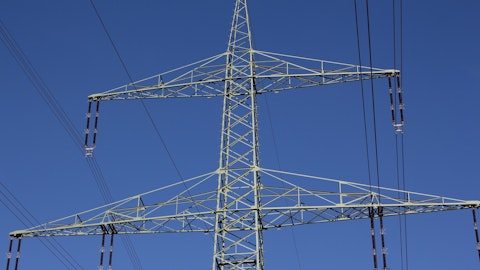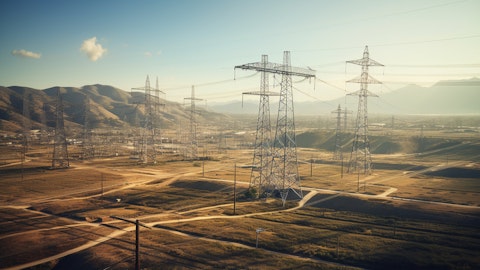Pedro Pizarro: Yes, so through EEI, we’re really engaged on that, and a number of Capitol Hill visits, look, you’re right, it’s kind of hard to get a national budget pass these days, right? So it is a challenging environment in Capitol Hill. On the other hand, this is not a single state issue anymore. It’s multiple states. They’re red, blue, and everything in between, right? And so I think there’s increasing recognition that there is a challenge here that needs a national solution. Still framing that up, but I will point to the fact that there’s examples for other risks across the economy, where there is a national-level solution. Think about managing nuclear operating risk and the Price-Anderson Act is an example. Steve, I know you’ve been engaged in a number of these Capitol Hill discussions as well. Anything you would add?
Steven Powell: I’d just say right now, we’ve been really focused on education about how the risk is evolving and the mitigations that the industry’s taking to manage the physical risk itself. In terms of the financial risk, I think there’s — I know that different states are approaching it in different ways. We’ll look for ways that you can combine what’s being done at the state level with potentially complementary efforts at the federal level. Some of the things that I know there’s interest in on the Hill even things like being able to remove timber and there’s lots of tactical things around permitting and allowing utilities to effectively streamline the process to get their work done in high-fire areas. In terms of more of the financial solution, again, I think that there’s a lot of work to be done even just to shape what the ask is and it’ll take some time, but it’s most likely to be some combination of state solutions with attempts at the federal level.
Jeremy Tonet: Got it, that’s very helpful. And just a quick point of clarification, if I could, with regards to the deadline for the point of extensions there, I think it might’ve said in the coming months is the deadline, is there any specific date and time that we should be looking for there?
Maria Rigatti: Right now, the deadlines are all over for the next couple of months, but we’ll keep you posted.
Jeremy Tonet: Got it. Thank you.
Pedro Pizarro: Hey, thanks for the good questions, Jeremy.
Operator: Thank you, our next question comes from Ryan Levine with Citi. Your line is open.
Ryan Levine: Hi, everybody. I’d be interested in terms of the cost structure. It looked like your O&M numbers ticked up year-over-year and your footnotes point to inspection and maintenance costs being higher this quarter. Is there anything to read into that or any color you could share around what’s driving some of the escalation on your costs?
Maria Rigatti: Yes, so a lot of that sometimes has to do with exactly when in each quarter you’re booking the cost. So, some of it’s just timing differences year-over-year. That can be driven by weather. In years where there’s worse weather than not, you’re going to do less work. And then, in another year, you can do more work. So, I think our cost structure is not changing per se. In fact, our focus is on how to actually streamline all of those processes and reduce the cost over time, so, nothing to read into that.
Ryan Levine: And then in terms of wildfire mitigation plans more broadly to the extent that this becomes the more national initiative for utilities around the country, are there opportunities to streamline maybe the cost of implementation or any iterations that you can anticipate as it becomes more of a nationwide phenomenon?
Pedro Pizarro: So, maybe a couple angles on that. One is, and I think you heard us say this earlier, Ryan, our team continues to look constantly for how do we refine, improve, how do we use new technologies, et cetera. So, maybe part of your question comes from a place of, I’ll make it up a little bit, and you tell me if this is the kind of thing you’re thinking about. To the extent that you have technologies that end up being deployed on a more mass scale across multiple states, in theory, conceptually, that might lead to maybe some streamlining of those costs if you have greater adoption driving greater scale. But I think from an SCE perspective, the team there is very focused on constantly turning the crank, refining our view of the risk, refining the view of the models underlying our description of that risk, and then prioritizing and reprioritizing the capital and O&M commitments that we make towards further reducing that risk. Steve, anything else?
Steven Powell: Yes, Ryan, as I think about the experience we’ve been through and the focus we have on both balancing affordability as we make sure we’re mitigating the wildfire risk, it starts for any utility that’s going down the path of making the right decisions around the risk mitigations you deploy. So, for example, for us, on our grid hardening side, covered conductor is a very cost effective way for us to address the risks that we face, may look different for different utilities. As you get into things like inspections, it’s the things we’ve done around combining our aerial and our ground inspections, so we’re having to go out fewer times to do the inspections. The tools we use to do that are ones that certainly, if they’re able to help us bring the cost down, as more and more people are developing those, those may improve and we may have more opportunities.





